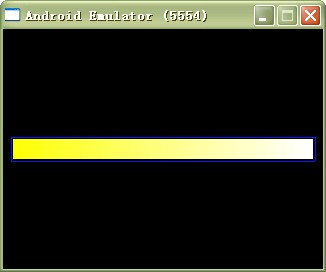Android原生(Native)C开发之二:framebuffer篇
摘要 虽然现在能通过交叉环境编译程序,并push到Android上执行,但那只是console台程序,是不是有些单调呢?下面就要看如何通过Linux的framebuffer技术在Android上画图形,关于Linux的framebuffer技术,这里就不再详细讲解了,请大家google一下。 操作framebuffer
虽然现在能通过交叉环境编译程序,并push到Android上执行,但那只是console台程序,是不是有些单调呢?下面就要看如何通过Linux的 framebuffer 技术在Android上画图形,关于Linux的framebuffer技术,这里就不再详细讲解了,请大家google一下。
操作framebuffer的主要步骤如下:
1、打开一个可用的FrameBuffer设备;
2、通过mmap调用把显卡的物理内存空间映射到用户空间;
3、更改内存空间里的像素数据并显示;
4、退出时关闭framebuffer设备。
下面的这个例子简单地用framebuffer画了一个渐变的进度条,代码 framebuf.c 如下:
#include <unistd.h>
#include <stdio.h>
#include <fcntl.h>
#include <linux/fb.h>
#include <sys/mman.h>
inline static unsigned short int make16color(unsigned char r, unsigned char g, unsigned char b)
{
return (
(((r >> 3) & 31) << 11) |
(((g >> 2) & 63) << 5) |
((b >> 3) & 31) );
}
int main() {
int fbfd = 0;
struct fb_var_screeninfo vinfo;
struct fb_fix_screeninfo finfo;
long int screensize = 0;
char *fbp = 0;
int x = 0, y = 0;
int guage_height = 20, step = 10;
long int location = 0;
// Open the file for reading and writing
fbfd = open("/dev/graphics/fb0", O_RDWR);
if (!fbfd) {
printf("Error: cannot open framebuffer device.\n");
exit(1);
}
printf("The framebuffer device was opened successfully.\n");
// Get fixed screen information
if (ioctl(fbfd, FBIOGET_FSCREENINFO, &finfo)) {
printf("Error reading fixed information.\n");
exit(2);
}
// Get variable screen information
if (ioctl(fbfd, FBIOGET_VSCREENINFO, &vinfo)) {
printf("Error reading variable information.\n");
exit(3);
}
printf("sizeof(unsigned short) = %d\n", sizeof(unsigned short));
printf("%dx%d, %dbpp\n", vinfo.xres, vinfo.yres, vinfo.bits_per_pixel );
printf("xoffset:%d, yoffset:%d, line_length: %d\n", vinfo.xoffset, vinfo.yoffset, finfo.line_length );
// Figure out the size of the screen in bytes
screensize = vinfo.xres * vinfo.yres * vinfo.bits_per_pixel / 8;;
// Map the device to memory
fbp = (char *)mmap(0, screensize, PROT_READ | PROT_WRITE, MAP_SHARED,
fbfd, 0);
if ((int)fbp == -1) {
printf("Error: failed to map framebuffer device to memory.\n");
exit(4);
}
printf("The framebuffer device was mapped to memory successfully.\n");
//set to black color first
memset(fbp, 0, screensize);
//draw rectangle
y = (vinfo.yres - guage_height) / 2 - 2; // Where we are going to put the pixel
for (x = step - 2; x < vinfo.xres - step + 2; x++) {
location = (x+vinfo.xoffset) * (vinfo.bits_per_pixel/8) +
(y+vinfo.yoffset) * finfo.line_length;
((unsigned short int)(fbp + location)) = 255;
}
y = (vinfo.yres + guage_height) / 2 + 2; // Where we are going to put the pixel
for (x = step - 2; x < vinfo.xres - step + 2; x++) {
location = (x+vinfo.xoffset) * (vinfo.bits_per_pixel/8) +
(y+vinfo.yoffset) * finfo.line_length;
((unsigned short int)(fbp + location)) = 255;
}
x = step - 2;
for (y = (vinfo.yres - guage_height) / 2 - 2; y < (vinfo.yres + guage_height) / 2 + 2; y++) {
location = (x+vinfo.xoffset) * (vinfo.bits_per_pixel/8) +
(y+vinfo.yoffset) * finfo.line_length;
((unsigned short int)(fbp + location)) = 255;
}
x = vinfo.xres - step + 2;
for (y = (vinfo.yres - guage_height) / 2 - 2; y < (vinfo.yres + guage_height) / 2 + 2; y++) {
location = (x+vinfo.xoffset) * (vinfo.bits_per_pixel/8) +
(y+vinfo.yoffset) * finfo.line_length;
((unsigned short int)(fbp + location)) = 255;
}
// Figure out where in memory to put the pixel
for ( x = step; x < vinfo.xres - step; x++ ) {
for ( y = (vinfo.yres - guage_height) / 2; y < (vinfo.yres + guage_height) / 2; y++ ) {
location = (x+vinfo.xoffset) * (vinfo.bits_per_pixel/8) +
(y+vinfo.yoffset) * finfo.line_length;
if ( vinfo.bits_per_pixel == 32 ) {
*(fbp + location) = 100; // Some blue
*(fbp + location + 1) = 15+(x-100)/2; // A little green
*(fbp + location + 2) = 200-(y-100)/5; // A lot of red
*(fbp + location + 3) = 0; // No transparency
} else { //assume 16bpp
unsigned char b = 255 * x / (vinfo.xres - step);
unsigned char g = 255; // (x - 100)/6 A little green
unsigned char r = 255; // A lot of red
unsigned short int t = make16color(r, g, b);
((unsigned short int)(fbp + location)) = t;
}
}
//printf("x = %d, temp = %d\n", x, temp);
//sleep to see it
usleep(200);
}
//clean framebuffer
munmap(fbp, screensize);
close(fbfd);
return 0;
}
注意,在Android环境,framebuffer设备不是象linux一样的 /dev/fb0,而是 /dev/graphics/fb0,
fbfd = open("/dev/graphics/fb0", O_RDWR);
打开framebuffer设备,
fbp = (char *)mmap(0, screensize, PROT_READ | PROT_WRITE, MAP_SHARED,
fbfd, 0);
将设备map到一块内存,然后就可以操作这块内存空间来显示你想画的图形了。
最后别忘了关闭设备:
munmap(fbp, screensize);
close(fbfd);
效果图如下:






